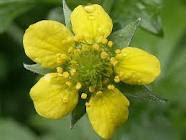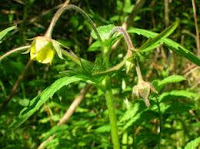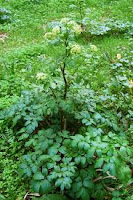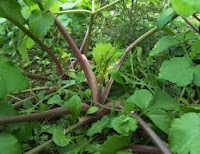Avens or wood avens, Geum urbanum is a close relative of the water avens or Indian chocolate (Geum rivale) and a member of the Rosaceae or rose family, making it a relative of the dog rose. As a member of this family it is a distant relative of apricots, apples, plums, loquats, peaches and the blackthorn tree from which we get sloes. It is closely related to the Potentilla genus, so is related to silverweed and cinquefoil, which its yellow flowers resemble.
The avens is native to Britain Europe as well as to Central Asia . Its root when freshly dug has a strong smell of cloves, and this is the reason for its genus name Geum, which basically means something with a fragrant aroma. The name urbanum means of the city, or perhaps sophisticated.
It was believed that the root was best gathered in Britain
 The root is the part generally used in medicine: ½ ounce of root chopped to one pint of boiling water can be infused and then strained and the liquid drunk cold, or the decoction can be made by boiling the root and reducing the amount of water to ½ a pint. This can be used externally for skin problems, and for vaginal discharge, as an antiseptic and wound healer and internally for stomach problems, to soothe the mucous membranes in bronchitis and coughs, for sore throats and headaches, as a drink to reduce fevers, and as a general spring tonic, which was believed to clear obstructions in the liver and cleanse the blood and body.
The root is the part generally used in medicine: ½ ounce of root chopped to one pint of boiling water can be infused and then strained and the liquid drunk cold, or the decoction can be made by boiling the root and reducing the amount of water to ½ a pint. This can be used externally for skin problems, and for vaginal discharge, as an antiseptic and wound healer and internally for stomach problems, to soothe the mucous membranes in bronchitis and coughs, for sore throats and headaches, as a drink to reduce fevers, and as a general spring tonic, which was believed to clear obstructions in the liver and cleanse the blood and body. The root contains tannin and so it is useful as an astringent for diarrhoea and dysentery as well as for wound healing.
Nicholas Culpeper the English herbalist writing in the 17th century wrote about it in this way: -
 “Government and virtues. It is governed by Jupiter, and that gives hopes of a wholesome healthful herb. It is good for the diseases of the chest or breast, for pains, and stiches in the side, and to expel crude and raw humours from the belly and stomach, by the sweet savour and warming quality. It dissolves the inward congealed blood happening by falls or bruises, and the spitting of blood, if the roots, either green or dry, be boiled in wine and drank; as also all manner of inward wounds or outward, if washed or bathed therewith. The decoction also being drank, comforts the heart, and strengtheneth the stomach and a cold brain, and therefore is good in the spring-time to open obstructions of the liver, and helps the wind cholic; it also helps those that have fluxes, or are bursten, or have a rupture; it taketh away spots or marks in the face, being washed therewith. The juice of the fresh root, or powder of the dried root, hath the same effect with the decoction. The root in the spring time steeped in wine, give it delicate savour and taste, and being drank fasting every morning, comforteth the heart, and is a good preservative against the plague, or any other poison. It helpeth digestion, and warmeth a cold stomach, and openeth obstructions of the liver and spleen.”
“Government and virtues. It is governed by Jupiter, and that gives hopes of a wholesome healthful herb. It is good for the diseases of the chest or breast, for pains, and stiches in the side, and to expel crude and raw humours from the belly and stomach, by the sweet savour and warming quality. It dissolves the inward congealed blood happening by falls or bruises, and the spitting of blood, if the roots, either green or dry, be boiled in wine and drank; as also all manner of inward wounds or outward, if washed or bathed therewith. The decoction also being drank, comforts the heart, and strengtheneth the stomach and a cold brain, and therefore is good in the spring-time to open obstructions of the liver, and helps the wind cholic; it also helps those that have fluxes, or are bursten, or have a rupture; it taketh away spots or marks in the face, being washed therewith. The juice of the fresh root, or powder of the dried root, hath the same effect with the decoction. The root in the spring time steeped in wine, give it delicate savour and taste, and being drank fasting every morning, comforteth the heart, and is a good preservative against the plague, or any other poison. It helpeth digestion, and warmeth a cold stomach, and openeth obstructions of the liver and spleen.” He concluded his description with this: “It is very safe; you need have no dose prescribed; and is very fit to be kept in every body's house.”
It was used to flavour Augsburg Ale to impart both its flavour and its health-giving properties, with a sachet of the root being placed in each cask of ale. In the Middle Ages it used to be worn as an amulet to ward off evil spirits and venomous beasts, as it was regarded as a sacred herb, belonging to Saint Benedict, hence the name Herb Bennet (a corruption of Benedict).
 The trefoil leaf of this plant with its golden, five petalled flower was a symbol of the Holy Trinity (trefoil leaf) while the five petals symbolized the five wounds inflicted upon the crucified Jesus. By the end of the 13th century in
The trefoil leaf of this plant with its golden, five petalled flower was a symbol of the Holy Trinity (trefoil leaf) while the five petals symbolized the five wounds inflicted upon the crucified Jesus. By the end of the 13th century in (Hemlock is also called Herb Bennet and should not be confused with this. Legend has it that a monk gave Saint Benedict a cup of wine poisoned by hemlock, but when Saint Benedict blessed the wine before drinking it, the poison, which was a kind of devil, fled the cup with such force that it shattered, thus exposing the cup-bearing monk’s intent to kill Saint Benedict.)
 So far there is no scientific evidence to support the traditional medicinal uses of avens, or Herb Bennet.
So far there is no scientific evidence to support the traditional medicinal uses of avens, or Herb Bennet.







































